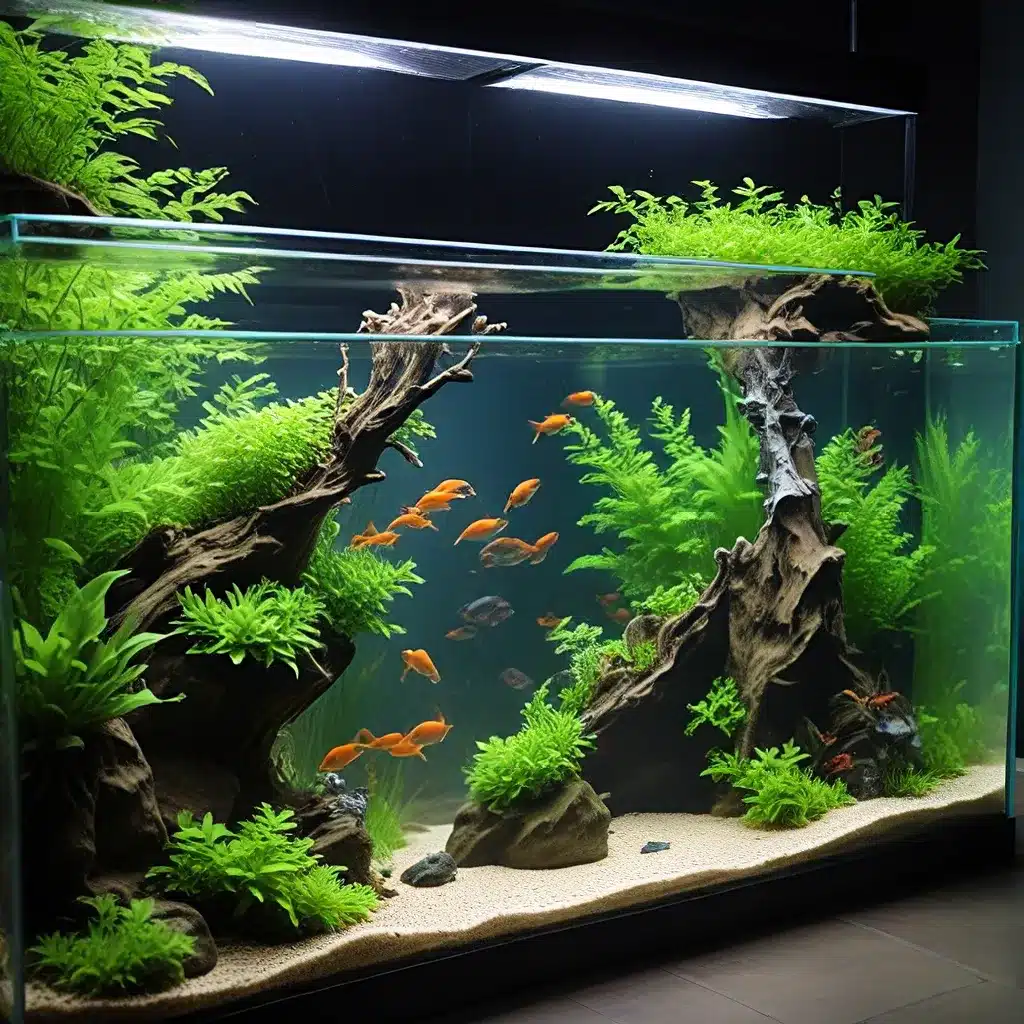
Embracing Eco-Friendly Aquarium Setups
As aquarists, we have a unique opportunity to make a positive impact on the environment through our aquarium hobbies. By adopting sustainable practices, we can reduce our aquatic footprint and contribute to a greener future for our aquatic ecosystems. In this comprehensive guide, we’ll explore various ways to incorporate eco-friendly techniques into your aquarium setup and maintenance routines, ensuring your underwater oasis is not only visually stunning but also environmentally responsible.
Minimizing Energy Consumption
One of the cornerstones of sustainable aquarium practices is energy conservation. The continuous operation of aquarium equipment, such as filters, heaters, and lighting, can have a significant impact on your energy usage and carbon footprint. To reduce your energy consumption, consider the following strategies:
Upgrade to energy-efficient LED lighting. LED bulbs not only consume significantly less power than traditional incandescent or fluorescent options, but they also generate less heat, reducing the strain on your aquarium’s cooling system. Look for LED fixtures that provide the necessary lighting for your planted or reef tank without overloading your electrical system.
Invest in a high-efficiency filtration system. Modern filter designs, such as canister filters and protein skimmers, can deliver superior water quality while utilizing less energy compared to older, less efficient models. Additionally, consider upgrading to a high-quality aquarium chiller that operates using renewable energy sources like geothermal or solar power.
Harnessing Renewable Energy
Taking your aquarium’s energy efficiency a step further, you can explore the integration of renewable energy sources. Solar panels and geothermal systems are two promising options that can help power your aquarium setup, reducing your reliance on traditional electrical grids.
Solar panels, when strategically placed, can capture the sun’s energy and convert it into electricity to run your aquarium’s essential components. This not only reduces your carbon footprint but also provides a reliable and sustainable power source, especially for setups located in areas with abundant sunlight.
Geothermal systems, on the other hand, utilize the stable temperatures found underground to heat and cool your aquarium’s water, minimizing the need for energy-intensive heaters and chillers. These systems can be particularly beneficial for hobbyists in regions with extreme temperatures, helping to maintain the ideal conditions for your aquatic inhabitants.
Water Conservation and Recycling
Water is a precious resource, and responsible aquarium enthusiasts should strive to conserve and recycle water wherever possible. One simple yet effective approach is to implement water-efficient water change routines. By reducing the frequency and volume of water changes, you can minimize the amount of freshwater required to maintain your aquarium’s optimal water quality.
Another innovative strategy is to incorporate water recycling systems. These systems, often known as aquaponic setups, allow you to reuse the nutrient-rich water from your aquarium to nourish aquatic plants. The plants, in turn, help to filter the water, creating a closed-loop system that reduces overall water consumption.
Sustainable Aquascaping Techniques
The art of aquascaping, or the design and arrangement of aquatic plants and hardscape elements, presents an excellent opportunity to incorporate sustainable practices. When planning your aquarium’s layout, consider the following eco-friendly aquascaping techniques:
Prioritize native and hardy plant species. By selecting plants that are native to the region or well-suited to your aquarium’s conditions, you can reduce the need for intensive care, such as frequent pruning or supplementation. These plants are often more resilient and require fewer resources to thrive.
Incorporate renewable and repurposed materials into your aquascape. For example, use driftwood, rocks, or recycled glass to create visually appealing structures, minimizing the need for energy-intensive manufacturing processes.
Explore low-tech aquascaping methods, such as the Walstad method, which utilizes a balanced ecosystem of plants, substrate, and beneficial bacteria to maintain water quality without the need for complex filtration systems or continuous mechanical intervention.
Waste Management and Recycling
Aquarium maintenance inevitably generates waste, but responsible hobbyists can implement strategies to reduce, reuse, and recycle various materials. Start by properly disposing of aquarium water during water changes, ensuring that it does not harm local ecosystems. Consider using the water to nourish your household plants or donate it to community gardens.
Compost fish waste and uneaten food instead of sending it to landfills. Many municipal composting facilities or even your own home compost bin can transform these organic materials into nutrient-rich soil amendments for your garden.
When it comes to equipment, strive to recycle or repurpose items such as filter media, tubing, and even old aquarium glass. Many local recycling centers or aquarium-specific programs can ensure that these materials are properly processed and reused.
Engaging the Aquarium Community
Sustainable aquarium practices are not just about individual actions; they involve fostering a collective commitment to environmental stewardship within the aquarium community. As aquarists, we can share our knowledge, inspire others, and collaborate to amplify the impact of our eco-friendly efforts.
Participate in eco-challenges or online initiatives that encourage aquarium enthusiasts to reduce their plastic consumption, conserve resources, and adopt sustainable practices. Engage with local aquarium clubs, shops, and organizations to promote awareness and organize community-based sustainability projects.
By leading by example and engaging with fellow hobbyists, we can create a ripple effect that inspires others to adopt sustainable aquarium practices, ultimately contributing to a greener and more resilient future for our aquatic ecosystems.
Conclusion
Embracing sustainable aquarium practices is not just a responsible choice; it’s a necessary step in preserving the delicate balance of our aquatic environments. By implementing energy-efficient technologies, harnessing renewable energy, conserving water, and adopting eco-friendly aquascaping techniques, we can reduce our aquatic footprint and contribute to a more sustainable future.
Remember, every small action we take as aquarium enthusiasts can have a profound impact. Let’s work together to create a thriving, environmentally conscious aquarium community that sets an example for others to follow. With dedication and innovation, we can cultivate aquatic oases that are not only visually stunning but also serve as models of environmental stewardship.

